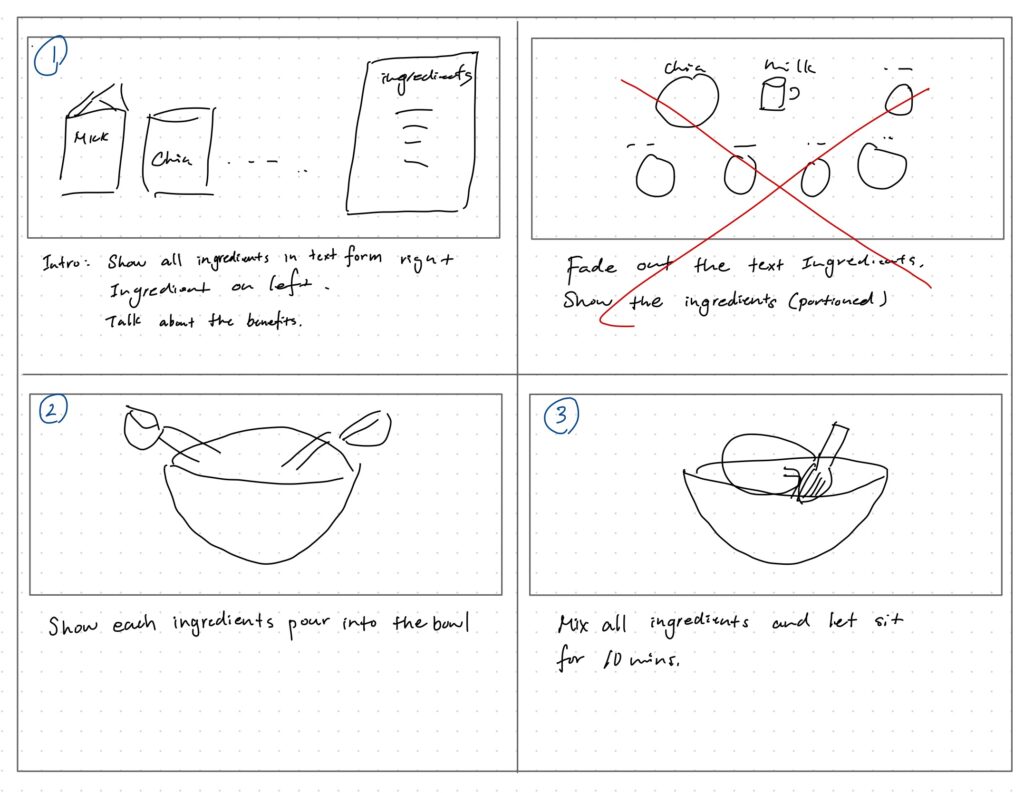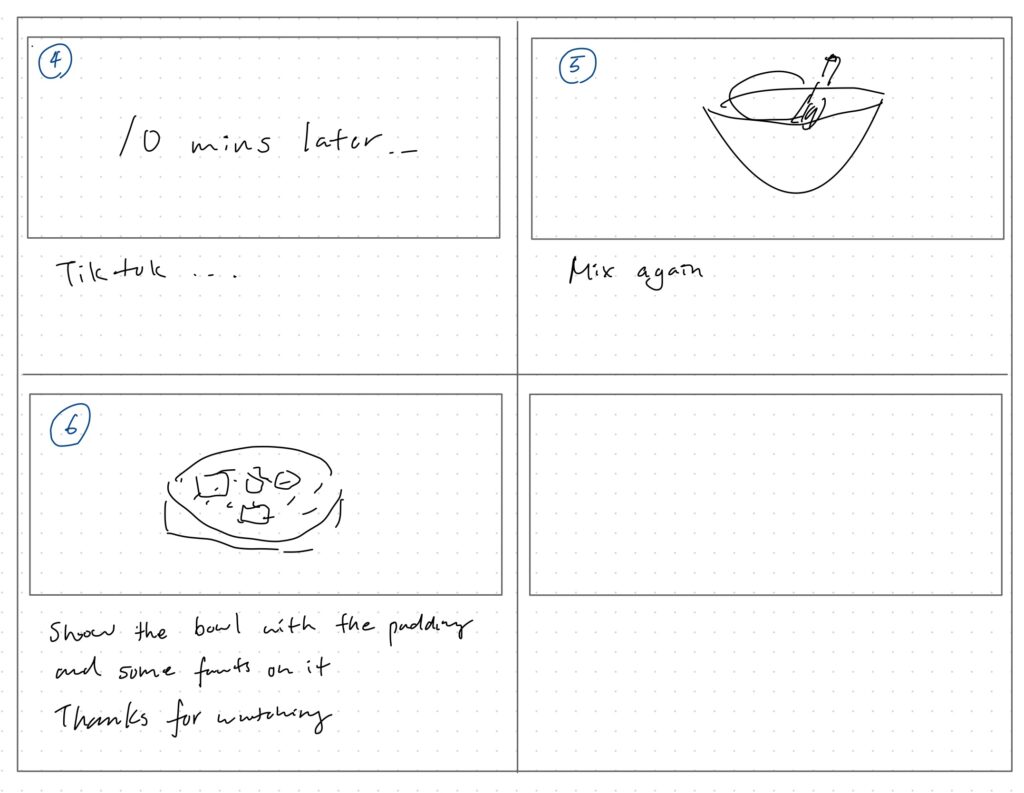What is the purpose of my video?
I aimed to create a video that resonates with and provides practical value for university students. Many of us transition to independent living and begin cooking for ourselves when we enter university. However, I’ve noticed that cooking can be a challenge for many, and figuring out what to make can be particularly difficult. University life often becomes hectic, leaving little time to prepare meals every day. So, I decided to share a simple recipe for a breakfast/snack item: Chia pudding. This dish requires only four ingredients, all readily available in any grocery store. It’s affordable and requires just mixing to prepare
Why is video a good medium for this learning purpose?
I believe that following cooking instructions becomes significantly easier when presented in video format rather than just plain text. With written instructions alone, it can be challenging to visualize the steps involved, especially when the dish is unfamiliar. This lack of visual aid often leaves us uncertain if we’re following the instructions correctly, leading to doubts and confusion. Sometimes, we only realize our mistakes at the very end of the cooking process, or even after the dish is completed, leaving us unsure if it’s supposed to look a certain way.
Videos offer the advantage of pausing or rewinding when we feel lost. Each step is visually demonstrated, allowing us to confirm that we’re on the right track. Additionally, watching the process unfold can serve as an encouragement for viewers to try cooking themselves. Lengthy written instructions can seem overwhelming, but witnessing the process firsthand makes it appear more manageable. Viewers can easily picture themselves recreating the dish, enhancing their confidence in their cooking abilities.
Which principles we’ve learned this term did I incorporate into my design and why?
When writing the script and storyboard, I made sure to stay on topic and be concise, applying Mayer’s coherence principle. I considered adding background music, fun animations, and transitions, but I concluded that background music might distract viewers from listening to the instructions. I minimized the number of transitions in the video, believing it’s crucial to use them judiciously. Overusing transitions can unnecessarily prolong the video and waste viewers’ time. Therefore, I incorporated transitions only when necessary to maintain a smooth flow and avoid distractions, aligning with Mayer’s segmenting principle. According to our readings in Module 3, research has shown that learners are most likely to retain the content of the video if it is less than 5 minutes in length. I believe this is true, as short content has become popular these days, reflecting people’s short attention spans. Ensuring the content stays on topic and avoiding unnecessary effects helped keep the video short.
Additionally, I made an effort to apply universal design and learning principles by adding subtitles to this video, an improvement from my previous video for this course. I carefully chose to use a white font with a dark background for the subtitles to help learners see and read better. In response to feedback from my last assignment, I also increased the audio volume for better audio quality.
What was challenging about capturing your own video?
One unexpected challenge I encountered was the struggle to find adequate lighting and a suitable location. Both my residence and kitchen lack sufficient illumination, and adding more lights often resulted in distracting shadows in the video. The task of identifying a spot in my kitchen that offered adequate lighting while minimizing shadows was quite challenging.
However, I found that script writing, storyboarding and recording narration presented the most significant challenges. In particular, when it came to storyboarding, I struggled with determining the appropriate level of detail for actions such as angles and zooming. It was difficult for me to gauge how much detail was necessary and what constituted excessive detail. Visualizing a step-by-step plan was challenging, as I’ve grown accustomed to approaching video creation with a flexible mindset, often relying on a rough idea of how the final product should look and improvising as I film. However, as I work on the video creation, I’ve come to recognize the value of incorporating scripting and storyboarding into my workflow. While it may require more upfront planning and preparation, having a clear vision and roadmap for the video can help streamline the filming process and ensure a more polished final product. Especially if you have other people work on the same project, it helps ensure that everyone is on the same page and working towards the same goal.
Recording the narration proved to be quite challenging as well. I had to do numerous takes to get it right. Finding the appropriate tone for each word was particularly difficult. If I didn’t deliver a word with the right tone within a sentence, I had to rerecord, which was quite annoying. Through this process I realized that the way you enunciate words plays a significant role in setting the overall vibe.
What did I find easiest?
I wouldn’t say it was easy but editing the video was the easiest part of the whole process. Since I had previously created a video in Module 2, editing had become familiar to me. For this particular video, I decided to be more inclusive by adding subtitles. This led me to explore tools for auto-generating subtitles from the video, and I was amazed by how accurately they identified the words. While I did need to make some adjustments to words and punctuation, it required minimal effort compared to manually adding subtitles. I’m impressed by how advanced technology has become. Upon completing the editing and seeing the final product, there was a strong sense of accomplishment.
What would I do differently next time?
I would definitely like to explore various angles to provide depth and visual interest to the video, making it more engaging for the viewers. Additionally, I intend to experiment with different lighting setups. Depending on the demonstration, it is important to clearly show the color and texture of the subject to ensure that viewers can properly follow the demonstration. Moreover, varied lighting can further enhance the mood and atmosphere of the video.
Although I was unable to show my face in this video due to a lack of courage, I believe that incorporating shots of my face at strategic moments can not only add a lighthearted touch but also enhance the connection with the audience. Facial expressions can convey emotions and reactions that complement the demonstration of tasks with hands alone.
The script
Script 1:
Hi everyone! I’m going to show you how to make chia pudding. It’s a simple breakfast or snack food you can make easily and also perfect for meal prep so you can make many portions in advance.
Script 2:
Get a bowl or any container to mix all the ingredients in. I like to just use a glass container where I would store them later. All you have to do is pour everything in the container.
1/2 cup of milk
2 tablespoons of chia seeds
1 teaspoon of maple syrup
1/2 teaspoons of vanilla extract
Script 3:
Then mix mix mix the ingredients.
Script 4:
After you mixed the ingredients well we let it sit for 10 minutes.
Script 5:
After 10 minutes, you’ll see that the seeds have started to gel. And we do on more quick stir. Now it’s ready to eat.
Script 6:
Feel free to add any topping like fruits or nuts of your choice!
Thanks for watching.
The storyboard


Leave a Reply
You must be logged in to post a comment.